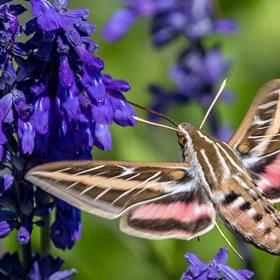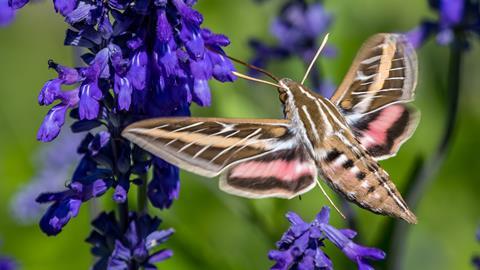Air pollution interferes with plant olfactory communication by accelerating the breakdown of volatile compounds. However, a recent study published in Science suggests that the effects of pollution are not as simple as they seem.
Plants use volatile organic compounds (VOCs) to communicate. ‘These are what we call specialised metabolites’, says Petra Bleeker, assistant professor of plant-insect interactions at the University of Amsterdam. These include terpenes, aromatic compounds, fatty acid catabolites and amino acid derivatives. ‘A plant produces these in interaction with its environment’,” explains Bleeker. Bees, for example, use plant volatiles to navigate around flowers containing nectar.
But once released, these volatiles have a short life span. UV radiation from the sun, together with ozone (O3) and atmospheric radicals such as hydroxyl radicals (OH) and nitrogen radicals (NOx), trigger their degradation. The radicals react with the carbon-carbon double bonds present in scents to produce a range of degradation products. The rate at which this happens depends on the concentration of volatile compounds and radicals.
‘It is this altered shape that is picked up by an insect’s antenna’
Petra Bleeker
Aerosols trap scents
‘This is not necessarily a problem in itself’, says Bleeker. ‘The volatile compound I was working on also changes after its initial emission when it comes into contact with the atmosphere, and it is this changed form that the insect antenna picks up.’ Silke Allmann, assistant professor of plant and tritrophic interactions at the University of Amsterdam, agrees: ‘It depends on whether the response signal to the scent is inherited, as in the case of pheromones, or whether it is something that they learn to recognise during their lives.’
However, the degradation of odours does not stop at this initial breakdown. As the breakdown products become increasingly oxidised, they begin to clump together to form what are known as secondary organic aerosols (SOAs). Pollution increases the number of radicals in the atmosphere, which in turn increases the rate of both volatile degradation and aerosol formation.
‘So it really seems that SOAs can also prime plants’
Silke Allmann
In this way, pollution not only causes the signal to degrade more rapidly, it also traps the alternative signal. How plants and insects respond to SOA is unknown, but studies on the influence of pollution on plant-insect and plant-plant communication are numerous and far from positive.
Air pollution shortens the influence of VOCs
Take the hawkmoth, for example. It can smell the pale evening primrose from a kilometre away. The hawkmoth uses the monoterpenes in the fragrance to help it find its way in the dark. But this doesn’t work so well in a polluted environment, where nitrogen radicals speed up the breakdown of monoterpenes. In this way, air pollution reduces the distance from which hawkmoths can smell pale evening primroses to about 400 metres.
The communication between the hawkmoth and the pale evening-primrose is not the only victim of pollution. ‘What we have found in both laboratory and field conditions is that air pollution essentially degrades the chemical signals that insects use to locate their host’, says James Ryalls, assistant professor of chemical ecology at the University of Reading. A recent study from his lab shows that the degradation of odours particularly hinders beneficial insects such as pollinators and natural pest controllers.
Air pollution essentially breaks down chemical signals’
James Ryalls
Air pollution also affects communication between plants. A plant damaged by herbivores releases a specific mixture of scents called herbivore-induced plant volatiles, or HIPVs. When the plant detects this mixture, it initiates a signalling cascade that leads to the activation of its defence response. Its leaves begin to produce substances that repel herbivores. The plant begins to release scents that attract predatory and parasitoid insects that can attack herbivores. And to keep them close, the plants release extra-floral nectar.
In this way, in a non-polluted environment, HIPVs from lima bean plants can warn plants at a distance of 70 centimetres. This changes the moment there is an increased concentration of ozone in the air. Lima bean plants in a mildly polluted environment still had a visible response to HIPVs at 20 centimetres, but not at 70 centimetres.
Scots pine responds to SOAs
‘We wanted to know what was really happening’, says James Blande, Professor of Chemical Ecology at the University of Eastern Finland. ‘We knew that when VOCs react with ozone, they can eventually form SOAs.’ The question was whether plants would also react to the clumped compounds. To investigate this, Blande and his team analysed the response of Scots pine to secondary organic compounds in their recent Science article. When attacked by herbivores, Scots pine produces many of the scents released by herbivores. ‘We expected ozone to have a negative effect on the interactions of Scots pine’, says Blande.

The SOAs needed for the study were produced by the researchers in a controlled way. They used the volatile compounds emitted by pine trees that had been damaged by weevils and those that hadn’t. The scents produced were collected and then exposed in an oxidative flow reactor to UV light and levels of ozone and hydroxyl radicals similar to those found in a mildly polluted environment. What was striking was the stark contrast between weevil-infested and non-infested Scots pine. While the former released large quantities of HIPVs, which the oxidative flow reactor was able to convert into SOAs, the latter released hardly any volatiles at all, which did not aggregate during their time in the oxidative flow reactor.
‘We expected ozone to have a negative effect on interactions’
James Blande
A Scots pine tree exposed to aerosols does not initially appear to react. It does not produce the insect-attracting scents that a Scots pine exposed to HIPVs does. But on closer inspection, the aerosol-exposed Scots pine was not completely unprepared. Just as the volatilised Scots pine was alerted, the aerosolised Scots pine increased its photosynthetic activity. In addition, the weevils ate less of the stem, and when they did, the Scots pine emitted more odours than a non-warned plant.
So not all the information from VOCs is lost when they break down and become aerosols. Something Blande finds intriguing. In the article, the researchers suggest that the difference in a plant’s response to VOCs and SOAs contributes to estimating the distance of the threat. ‘An interesting hypothesis’, say Bleeker and Allmann. ‘One that can lead to interesting studies’, Bleeker concludes.
‘Although it seems that SOAs can also prime plants’, says Allmann, “the question is what happens in nature.’ In nature, plants do not receive only volatiles or aerosols, but a mixture of both. Predatory and parasitoid insects can also help the plant. ‘If you really want to see if a SOA has a net positive effect, you have to look at the next generation and see if the plant produces more seeds’, says Allmann. All in all, the effect of air pollution on volatile communication is a mixed bag.
- Blande, J.D., et al., Air pollution impedes plant-to-plant communication by volatiles. Ecology Letters, (2010), https://doi.org/10.1111/j.1461-0248.2010.01510.x
- Chan, J. K., et al., Olfaction in the Anthropocene: NO3 negatively affects floral scent and nocturnal pollination, Science (2024), DOI: 10.1126/science.adi0858
- Ryalls, J.M.W., et al., Air pollution disproportionately impairs beneficial invertebrates: a meta-analysis. Nat Commun (2024), https://doi.org/10.1038/s41467-024-49729-5
- Yu, H., et al., Biogenic secondary organic aerosol participates in plant interactions and herbivory defense, Science (2024), DOI: 10.1126/science.ado6779













Nog geen opmerkingen